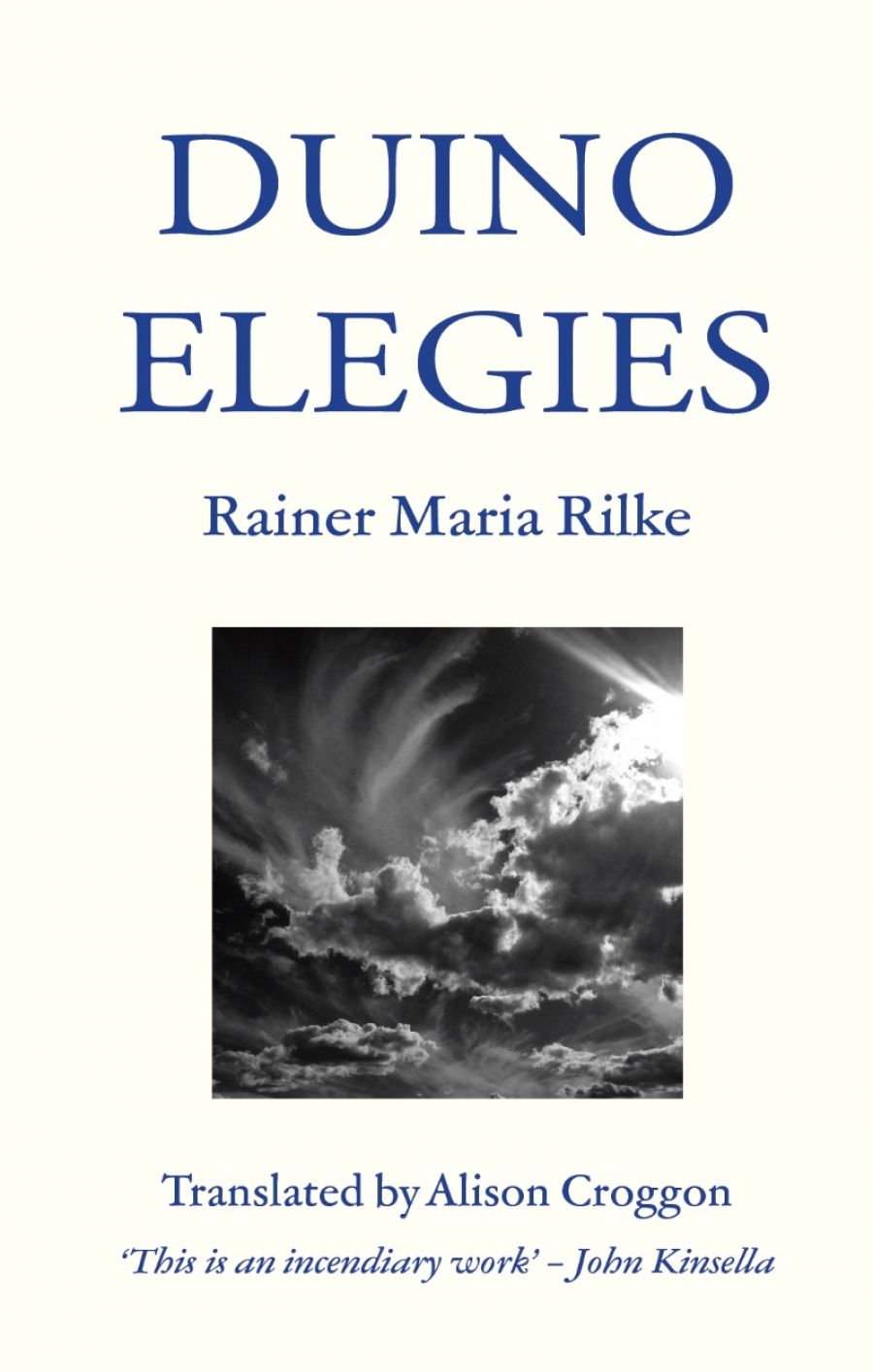
- Free Article: No
- Contents Category: Poetry
- Review Article: Yes
- Article Title: ‘This terrifying beginning’
- Article Subtitle: A new translation of Rilke’s masterpiece
- Online Only: No
- Custom Highlight Text:
Rainer Maria Rilke’s Duino Elegies were begun in a burst of inspiration while he was staying at Duino Castle near Trieste in 1912. Walking along the battlements after receiving a difficult business letter, he heard a mysterious voice calling to him from an approaching storm. Their composition was then interrupted by a personal and artistic crisis that lasted until 1922, when he finished them in an even more astonishing afflatus which also included the gift of their companion-masterpiece, the Sonnets to Orpheus, at the Château de Muzot in Switzerland.
- Featured Image (400px * 250px):

- Alt Tag (Featured Image): Humphrey Bower reviews 'Duino Elegies' by Rainer Maria Rilke, translated by Alison Croggon
- Book 1 Title: Duino Elegies
- Book 1 Biblio: Newport Street Books, $24.99 pb, 98 pp
- Book 1 Readings Link: booktopia.kh4ffx.net/NKVZ4N
Alison Croggon’s new translation of the Elegies has a directness, immediacy, sensuality, and violence that distinguishes her from precursors like J.B. Leishman and Stephen Spender (who together first introduced Rilke to the English-speaking world in a more elegant if somewhat mannered rendition) or Stephen Mitchell (who gives his Rilke a gentler, post-Beat, Zen-like spiritual cast).
Croggon, who is also a theatre writer and critic, has a feel for Rilke’s dramatic as well as lyrical voice and persona that is crucial to the Elegies, which are populated by a company of stock characters from the poet’s repertoire: angels, saints, puppets, dolls, actors, acrobats, clowns, dancers, musicians, lovers, gods, heroes and other mythological and scriptural figures, women (especially those who are betrayed or abandoned), children, animals, cripples, beggars, invalids, and those who die young.
As Rilke (or rather, his poet-subject dramatic persona) asks in Croggon’s translation of the rhetorical question that opens the First Elegy: ‘Who, if I cry, hears me among the angelic / orders?’ The use of the factual conditional present is more active and direct than the counterfactual conditional past of Leishman and Spender’s ‘Who, if I cried, would hear me’ or Mitchell’s ‘Who, if I cried out, would hear me’. Both are grammatically truer to the original ‘Wer, wenn ich schriee, hörte mich …’ but lack the simplicity and punch that Croggon shares with Rilke and conveys in terms of sheer sound.
 Alison Croggon (photograph via author's website)
Alison Croggon (photograph via author's website)
Further down in the same stanza, she interprets the line ‘Denn das Schöne ist nichts / als des Schrecklichen Anfang’ as ‘For beauty is nothing / but this terrifying beginning’ rather than ‘For beauty is nothing / but the beginning of terror’ (Mitchell). The latter is more faithful (‘des Schrecklichen Anfang’ literally means ‘the beginning of the terrifying’), but Croggon’s grammatical and semantic reversal is more dramatic and self-referential: ‘Here and now, these words are themselves a terrifying beginning!’
Croggon is also not afraid of false cognates. For example, in the Ninth Elegy, the praise of transience – ‘Aber dieses / ein Mal gewesen zu sein, wenn auch nur ein Mal: / irdisch gewesen zu sein, scheint nicht widerrufbar’ – is interpreted as: ‘But this / once was real, even if only once: / earthly and real, shining beyond revocation.’ Here, Mitchell’s translation reads: ‘But to have been / this once, completely, even if only once: / to have been at one with the earth, seems beyond undoing.’ In Croggon’s version, ‘shining’ is a playful homophone for scheint (‘seems’), but more concrete and suggestive than the literal reading. The whole passage is more striking and effective for being rendered in the preterite – ‘This, once, was real, even if only once: earthly and real’ – where Mitchell’s use of the future perfect infinitive ‘to have been’ is more abstract and speculative, as well as being clumsy and verbose.
Croggon’s prosody more or less follows Rilke’s own fairly loose adaptation of the rising and falling dactylic hexameters and pentameters of Greek and Roman elegy. She also exploits their natural affinity with the rhythms of colloquial English to evoke a more familiar and conversational tone compared with the somewhat formal language of Leishman and Spender or the more literal approach of Mitchell, which at times appears so transparent as to be almost colourless. Croggon also mimics Rilke’s generous use of alliteration, in a way that harks back to the common origins of Old English and Old High German and evokes those great early medieval Anglo-Saxon laments of loneliness and exile, The Wanderer and The Seafarer.
The final Elegy introduces a new group of characters to the dramatis personae. These are a strange species, race, class, or family of beings (the German word Geschlecht covers all of these group nouns, but Croggon opts for ‘family’) called ‘the Laments’ or ‘Lamentations’ (‘die Klage’) who appear in the meadows beyond the tawdry carnival on the outskirts of ‘the city of pain’. A young female Lament leads a newly dead young man into a ‘landscape of Lament’ that mirrors the familiar world, but also seems timeless. However, the word Klage is also a German translation of the Greek word elegos. In this light, ‘the Laments’ can also be read as personifications of the Elegies themselves, while the ‘landscape of Lament’ is also a linguistic one. Accordingly, Rilke’s poem-cycle is addressed as an offering to the dead, in order to lead and welcome them home.
Two brief final stanzas return us to ourselves and to the world of the living. The penultimate stanza presents the wintry images of ‘catkins hanging / from empty hazels’ and ‘rain falling on dark earth’. Croggon asserts at the end of her afterword that these lines encapsulate the radical immanence of the whole poem, and the closing stanza reinforces this bruising fall to earth: ‘And we, who think of happiness / climbing, would feel the emotion / which almost confounds us / when happiness falls.’ However, these lines also evoke the rhythm of rising and falling that animates elegaic (and possibly all) language (as well as all breath). This maintains the tension between immanence and transcendence, body and spirit, puppet and angel, that gives Rilke’s poetry and Croggon’s translation its sense of existential drama.


Comments powered by CComment